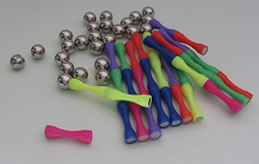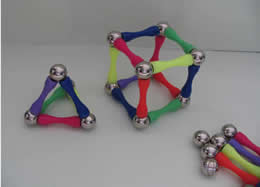Skip over navigation

I found this construction kit in a local supermarket - it cost me less than £2 and has 60 pieces - 35 sticks and 25 metal spheres.
The sticks are magnetic so that you can construct models by joining them with the metal spheres (more shortly).
I started to experiment and the first question I asked myself was whether I could make each of the platonic solids. How many sticks and spheres I would need for each one? That is for:
 I must admit that trying to construct the last two proved to be a
bit of a challenge but here is a picture of a cube and a
tetrahedron for you to see what I mean.
I must admit that trying to construct the last two proved to be a
bit of a challenge but here is a picture of a cube and a
tetrahedron for you to see what I mean.
This led me to think about how many of the skeleton platonic solids I could make in one go with the pieces available. So here is a cube and a tetrahedron. Would I be able to make an octahedron as well without running out of pieces? This felt highly likely but you might want to check.
But what combinations of solids are possible? For example could I make an icosahedron and a cube and an octahedron or would I run out of pieces?

All this led me on to the two final challenges I am going to pose for you:
Firstly, how many of each of the polyhedra could I make with the set? In the picture I have several tetrahedra - how many could I make altogether with my 60 pieces? How about cubes, octahedra and so on?
And finally, could I choose a selection of polyhedra that used all the pieces, if not what is the best I could do?


Or search by topic
Number and algebra
Geometry and measure
Probability and statistics
Working mathematically
Advanced mathematics
For younger learners
Magnetic Personality
Age 7 to 16
Challenge Level 





- Problem

I found this construction kit in a local supermarket - it cost me less than £2 and has 60 pieces - 35 sticks and 25 metal spheres.
The sticks are magnetic so that you can construct models by joining them with the metal spheres (more shortly).
I started to experiment and the first question I asked myself was whether I could make each of the platonic solids. How many sticks and spheres I would need for each one? That is for:
- A tetrahedron
- A cube
- An octohedron
- An icosahedron
- A dodecahedron

This led me to think about how many of the skeleton platonic solids I could make in one go with the pieces available. So here is a cube and a tetrahedron. Would I be able to make an octahedron as well without running out of pieces? This felt highly likely but you might want to check.
But what combinations of solids are possible? For example could I make an icosahedron and a cube and an octahedron or would I run out of pieces?

All this led me on to the two final challenges I am going to pose for you:
Firstly, how many of each of the polyhedra could I make with the set? In the picture I have several tetrahedra - how many could I make altogether with my 60 pieces? How about cubes, octahedra and so on?
And finally, could I choose a selection of polyhedra that used all the pieces, if not what is the best I could do?
You may also like
Proximity
We are given a regular icosahedron having three red vertices. Show that it has a vertex that has at least two red neighbours.
Platonic Planet
Glarsynost lives on a planet whose shape is that of a perfect regular dodecahedron. Can you describe the shortest journey she can make to ensure that she will see every part of the planet?

